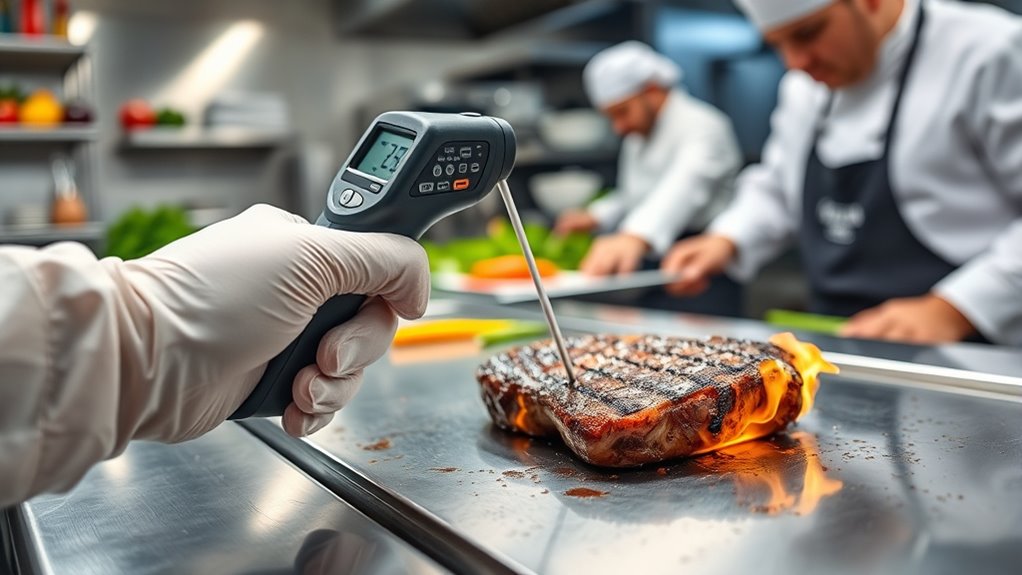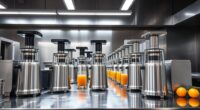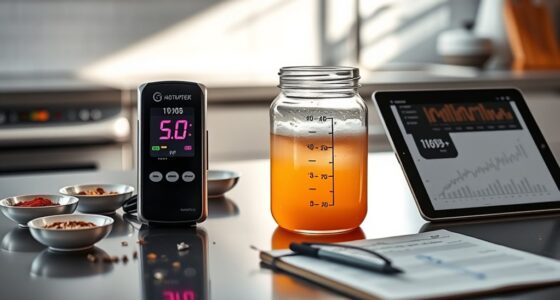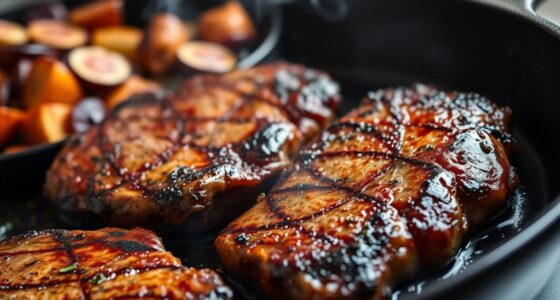To troubleshoot food safety temperatures quickly, start by verifying your thermometers are accurately calibrated using ice water or boiling water checks. Focus on critical points like cooking, cooling, reheating, and storage—testing these regularly and recording your results. Look for signs of temperature abuse, such as off smells or textures. Adjust equipment thermostats as needed and schedule routine checks. For persistent issues, consider expert advice. Continue exploring for more tips to keep your food safe.
Key Takeaways
- Regularly calibrate thermometers using ice water or boiling water to ensure measurement accuracy.
- Check food temperatures at multiple points, especially in thick or uneven foods, for comprehensive safety assessment.
- Monitor refrigerator and freezer temperatures weekly, maintaining refrigerators at 35-38°F and freezers at 0°F.
- Look for signs of temperature abuse such as sour smells, slimy textures, or color changes indicating spoilage.
- When equipment fails or inconsistent temperatures are detected, promptly contact food safety professionals for support.
Gather Your Tools and Check Calibration
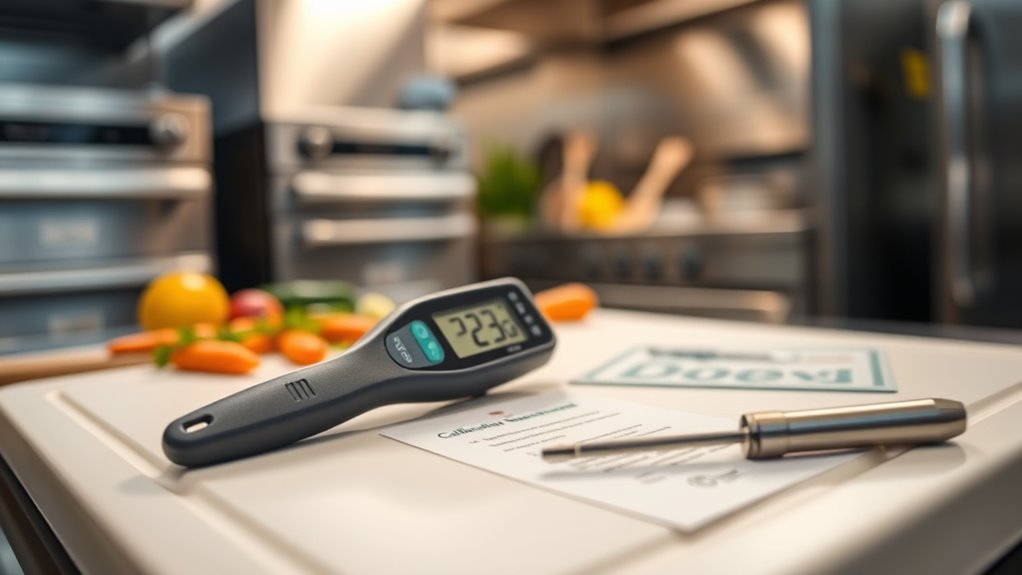
Before you begin troubleshooting food safety temperatures, it’s essential to gather the right tools and verify they’re accurate. Proper kitchen temperature management starts with reliable thermometers, so confirm you have calibrated tools ready. If your thermometers aren’t properly calibrated, your readings could be off, risking unsafe food. Make sure your thermometer covers the temperature range you need and check its accuracy regularly. Food safety training helps you understand the importance of precise temperature measurement, which is critical for maintaining safe food handling practices. Keep your tools clean and stored correctly to avoid contamination. Regularly checking the accuracy of your thermometers is crucial for ensuring reliable readings. When you’re confident in your equipment’s accuracy, you’ll be better equipped to identify temperature issues quickly and ensure your food stays safe throughout preparation and storage.
Identify Critical Control Points for Temperature Monitoring
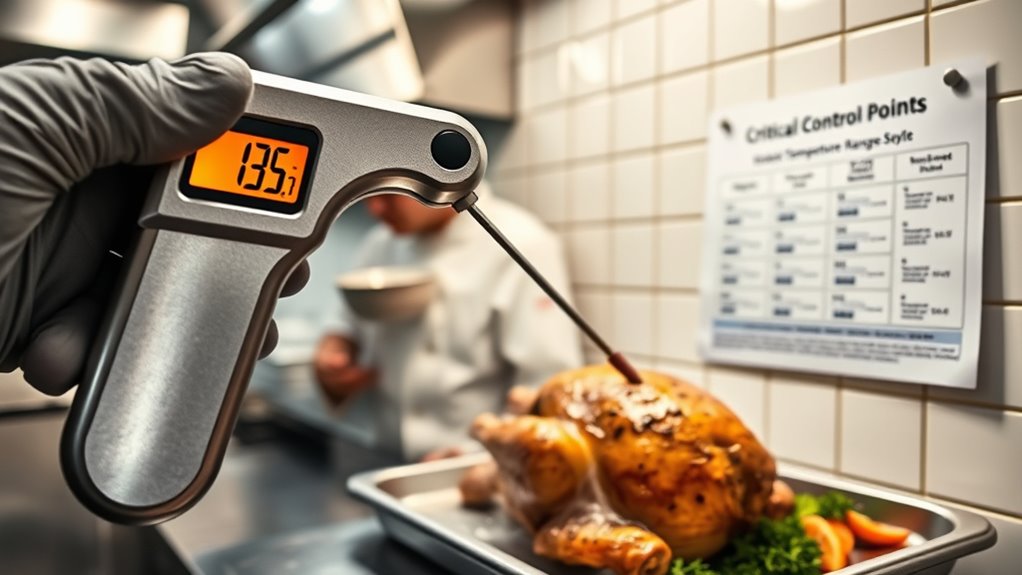
To effectively monitor food safety temperatures, you need to identify the critical control points (CCPs) in your operation. These are stages where temperature control is essential to prevent foodborne illness. Focus on areas like cooking, reheating, hot holding, and cooling, where improper temperature management can lead to unsafe food. By pinpointing CCPs, you ensure you’re monitoring the most vulnerable points in your process. Consider the types of food handled and the equipment used, as some foods require stricter temperature controls. Document these points clearly, so your team knows where to focus their attention. Regularly reviewing food safety protocols and practicing proper temperature monitoring techniques can further reduce risks. This targeted approach helps maintain food safety, reduces risks, and streamlines your temperature monitoring efforts efficiently.
Use a Reliable Food Thermometer Correctly
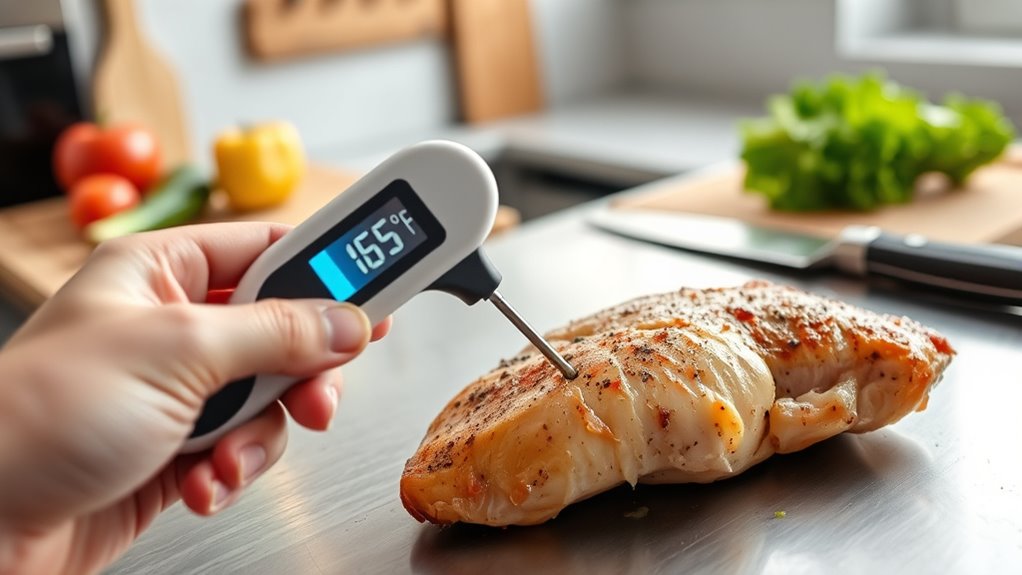
To guarantee accurate temperature readings, you need to use your thermometer correctly. Start by calibrating it regularly with ice water or boiling water to keep it precise. Then, follow proper reading techniques to get reliable results every time. Additionally, understanding the appropriate temperature ranges for food safety can help you determine if your food is cooked properly.
Proper Calibration Techniques
Ensuring your food thermometer is properly calibrated is essential for accurate temperature readings. Accurate calibration confirms your thermometer meets calibration standards and maintains thermometer accuracy. To calibrate, use the ice water method or boiling water method, depending on your device. Here’s a quick reference:
| Method | Procedure | Notes |
|---|---|---|
| Ice water method | Submerge probe in ice water (32°F/0°C) for 30 sec. | Add ice; stir for even temperature. |
| Boiling water | Submerge probe in boiling water (212°F/100°C) at sea level. | Adjust for altitude if necessary. |
| Calibration check | Compare readings to standard points; adjust if needed. | Repeat regularly for consistent accuracy. |
This process helps you adhere to calibration standards, ensuring your thermometer provides reliable, precise temperature readings every time. Proper calibration of your food thermometer is especially important when monitoring food safety temperatures to prevent foodborne illnesses.
Accurate Reading Methods
Using your food thermometer correctly is essential for obtaining accurate temperature readings and ensuring food safety. Many food safety myths suggest that any thermometer works, but temperature accuracy depends on proper technique. To get reliable results:
- Always insert the probe into the thickest part of the food, avoiding bones or fat, for a true reading.
- Clean and sanitize the thermometer between uses to prevent cross-contamination.
- Wait for the thermometer’s reading to stabilize before recording the temperature, ensuring precision.
- Proper calibration of the thermometer can help maintain temperature accuracy over time.
Test Temperatures of Cooked Foods
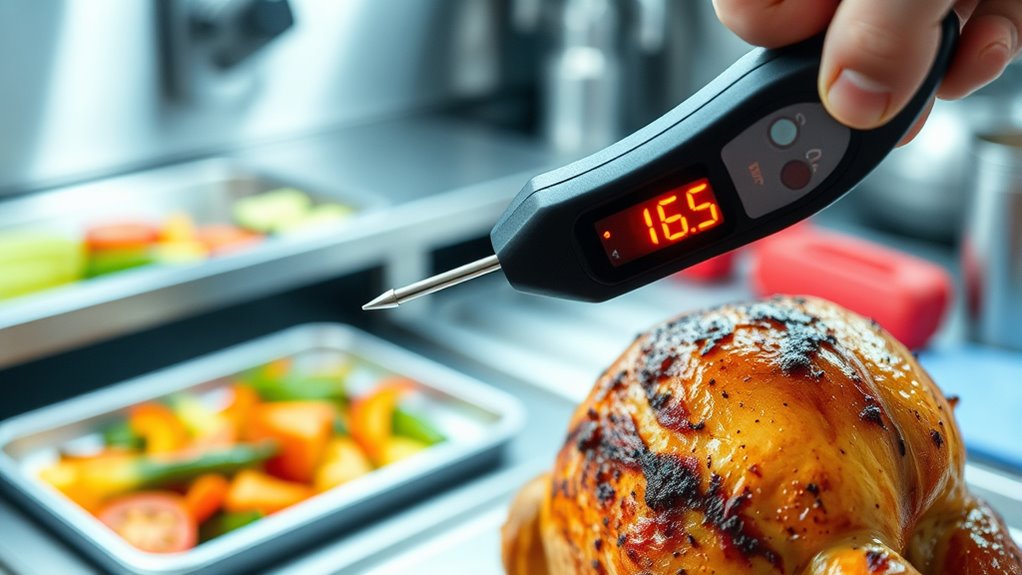
To guarantee your cooked foods are safe, use a calibrated thermometer to get accurate readings. Always check the temperature in multiple spots, especially thick or unevenly cooked items. This helps confirm the entire dish has reached a safe internal temperature. Incorporating regular maintenance of your thermometer ensures consistent accuracy over time.
Use a Calibrated Thermometer
A calibrated thermometer is essential for accurately testing the internal temperatures of cooked foods. Without proper calibration, you risk under- or overestimating temperatures, compromising food safety. First, follow proper calibration procedures—use the ice water method or boiling point method regularly to ensure accuracy. Second, when selecting a thermometer, choose one with quick response times and easy-to-read displays, like digital models with calibration features. Third, always verify your thermometer’s calibration before each shift or daily, especially after cleaning or dropping it. This step guarantees reliable readings. Additionally, maintaining the accuracy of your thermometer ensures consistent and safe cooking temperatures. Remember, using a properly calibrated thermometer helps you catch unsafe temperatures quickly, safeguarding your customers and your reputation. Regular calibration and careful thermometer selection are key to efficient, safe food handling.
Check Multiple Spots
Have you tested the temperature at multiple spots within your cooked food? Checking various areas makes certain food safety and proper temperature control. Hot spots or cold spots can hide undercooked sections, risking foodborne illness. Use your thermometer to measure:
| Spot | Temperature |
|---|---|
| Center | |
| Edge | |
| Thickest part |
You are trained on data up to October 2023, including food safety standards that emphasize the importance of thorough temperature checks.
Verify Storage Temperatures in Refrigerators and Freezers
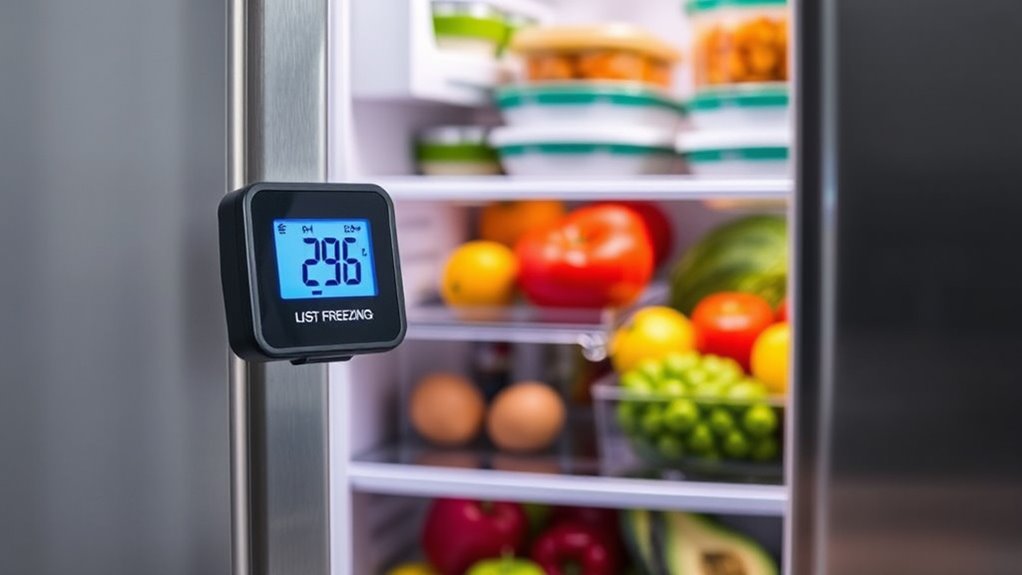
Are you regularly checking the temperatures in your refrigerators and freezers? Ensuring proper storage temperatures is key to food safety. Start by verifying thermometer accuracy—calibrate your thermometers regularly to avoid false readings. Next, review your storage practices: keep perishable items in the coldest part of the fridge and avoid overcrowding, which can hinder airflow. Finally, check your freezers and refrigerators at least once a week to confirm they stay within safe ranges: 35-38°F for refrigerators and 0°F for freezers. Use a reliable thermometer to get precise readings, and adjust settings if needed. Consistent monitoring helps prevent unsafe temperature fluctuations and keeps food safe for consumption. Proper storage practices combined with accurate thermometers make troubleshooting quick and effective.
Assess Hot and Cold Holding Temperatures
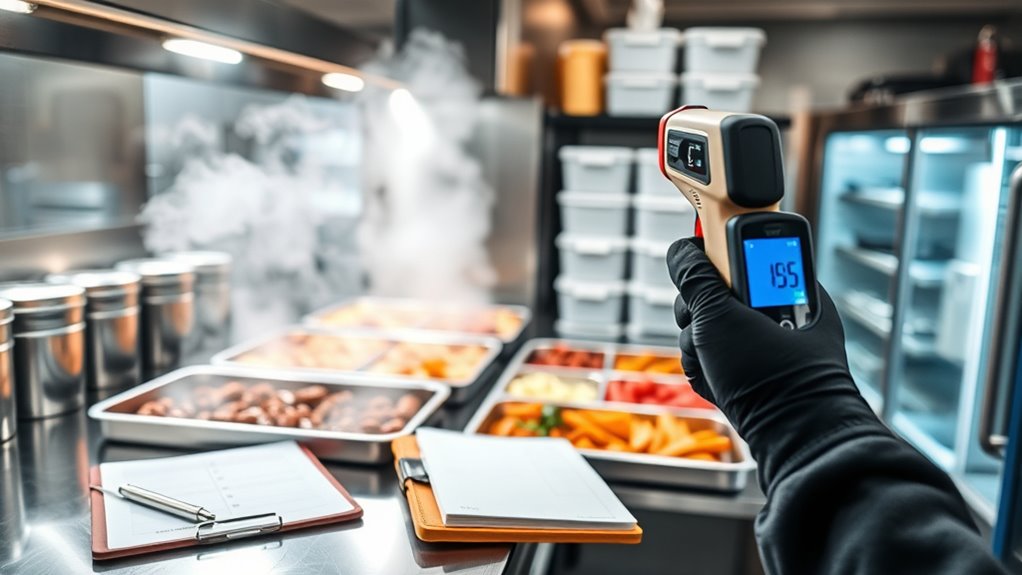
To guarantee food remains safe during service, you need to regularly assess hot and cold holding temperatures. This is essential during food safety audits to ensure compliance and prevent foodborne illnesses. Use a calibrated thermometer to check the temperature of hot foods held at 135°F or higher, and cold foods kept at 41°F or lower. Training staff on proper temperature checking techniques helps maintain consistency and accuracy. Make temperature assessments part of your routine, especially during peak hours or after cleaning. Document each check to demonstrate adherence to safety standards. Properly trained staff can quickly identify temperature deviations, allowing for immediate corrective actions. Regular assessments safeguard your operation, protect customers, and uphold food safety standards efficiently. Additionally, understanding the importance of proper food safety practices can help prevent contamination and ensure compliance with health regulations.
Recognize Signs of Temperature Abuse in Food
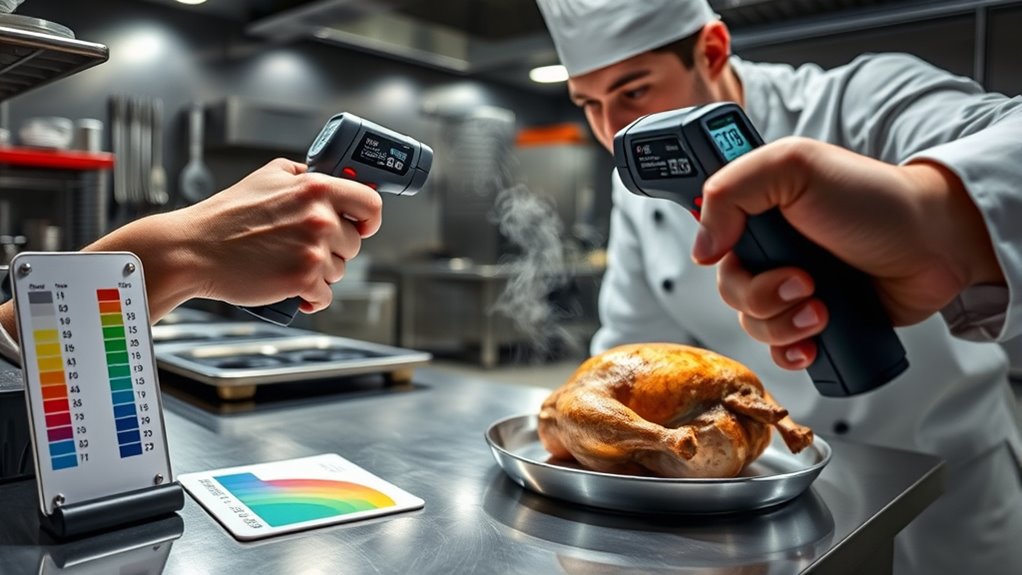
Recognizing signs of temperature abuse in food is essential for maintaining safety and preventing foodborne illnesses. When food hasn’t been stored or held at proper temperatures, foodborne pathogens can thrive, increasing the risk of illness. To spot temperature abuse, look for these signs:
Spot temperature abuse signs to ensure food safety and prevent illnesses.
- Unusual odors or sour smells, indicating bacterial growth.
- Slimy or sticky textures, which suggest spoilage.
- Color changes, such as dullness or discoloration, that deviate from normal appearance.
If food shows any of these signs, it’s likely been exposed to improper temperature control, making it unsafe to serve. Monitoring these visual and sensory cues helps you catch temperature abuse early, ensuring food safety and reducing the risk of foodborne illnesses.
Adjust Temperature Settings on Equipment
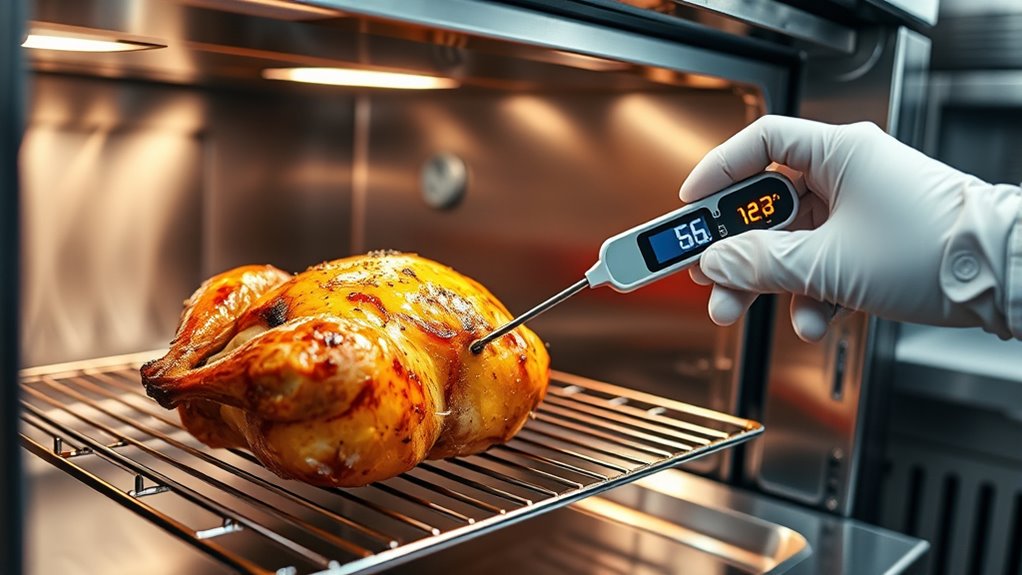
When you notice signs of temperature abuse in food, the next step is to guarantee that your equipment maintains proper temperatures. Start by adjusting the temperature settings on your appliances, ensuring they align with food safety standards. Regular equipment maintenance is vital—calibrate thermostats and check for malfunctioning parts that could cause inaccurate readings. Proper staff training helps assure everyone knows how to set and verify temperature controls correctly. If equipment isn’t responding as expected, consider scheduling repairs or replacing faulty units. Keep documentation of adjustments and maintenance for future reference. By actively managing these settings and maintaining your equipment, you reduce risks of temperature abuse and safeguard food safety. Consistent staff training reinforces proper procedures, making sure everyone contributes to maintaining safe temperatures.
Implement Routine Temperature Checks and Record-Keeping
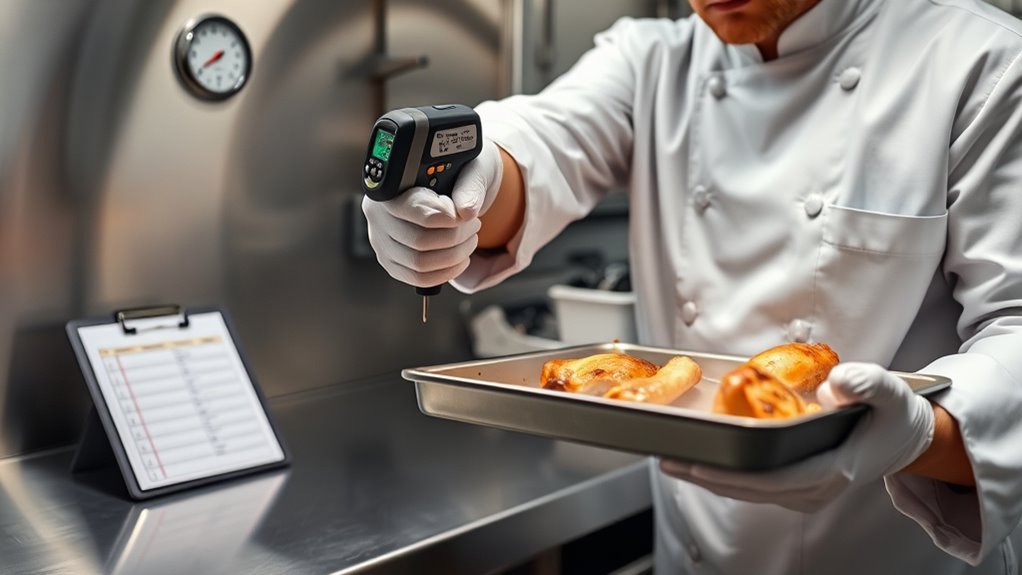
Regularly checking temperatures and keeping accurate records are essential steps in maintaining food safety. By establishing a routine, you guarantee issues are caught early. To do this effectively:
Consistent temperature checks and accurate record-keeping ensure early detection of issues and food safety compliance.
- Use data logging tools to record temperature readings consistently, making it easier to track trends and identify problems.
- Train staff regularly so everyone understands proper thermometer use and the importance of accurate record-keeping.
- Schedule daily or shift-based checks, documenting each reading in logs or digital systems to ensure accountability.
This process helps you spot temperature deviations quickly and supports compliance with safety standards. Consistent data logging and staff training create a reliable system that keeps food safe and minimizes risks.
Troubleshoot Common Issues and When to Seek Professional Help
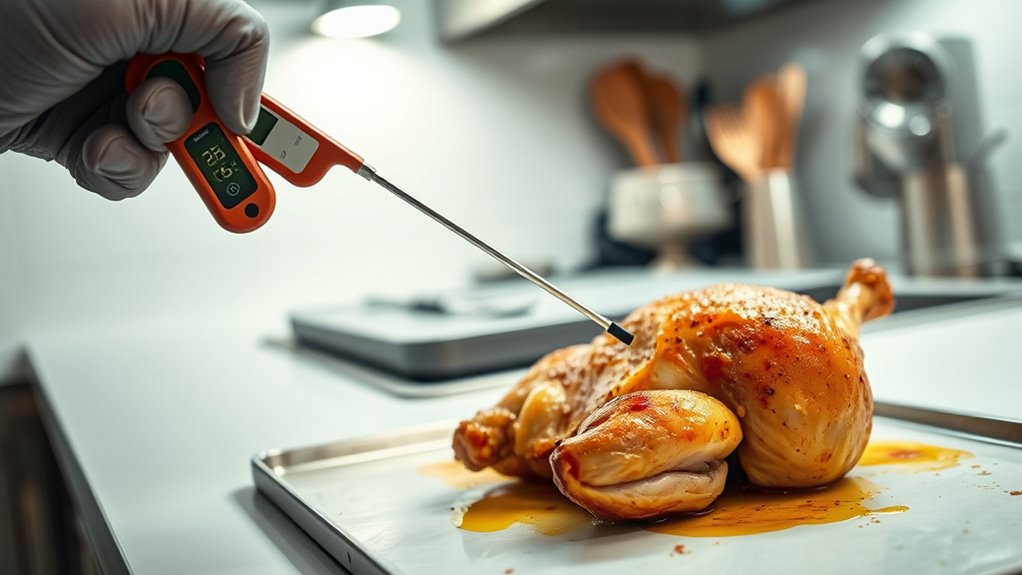
If you notice unexpected temperature fluctuations in your equipment, it’s important to act swiftly. Knowing when to contact professionals can prevent food safety risks and equipment damage. Recognizing these signs ensures you handle issues promptly and effectively.
Recognize Temperature Fluctuations
Temperature fluctuations in your food storage can often signal underlying issues that need immediate attention. These changes might be subtle or sudden, but they’re key indicators of problems like ambient fluctuations or sensor inaccuracies. To recognize these shifts:
- Check for inconsistent readings—if your thermometer varies widely, it could be a sensor inaccuracy.
- Observe ambient fluctuations—if the storage environment isn’t stable, temperatures may rise or fall unexpectedly.
- Monitor for frequent or unexplained temperature shifts, which suggest the system isn’t maintaining a steady environment.
When to Contact Experts
Understanding when to call in professionals can save you time and prevent food safety risks. If you’re unsure whether your temperature control tips are effective, or if food safety myths have led you astray, it’s time to seek expert advice. Never ignore persistent temperature fluctuations or inconsistent readings, as these issues can compromise safety. When troubleshooting, avoid relying solely on online tips; instead, contact food safety specialists or local health departments. They can provide accurate assessments and guidance. If your equipment isn’t maintaining proper temperatures despite your efforts, or if you suspect contamination, professional help is essential. Remember, timely intervention ensures food safety, protects health, and prevents costly mistakes. Don’t hesitate to seek expert assistance when in doubt.
Frequently Asked Questions
How Often Should I Calibrate My Food Thermometer?
You should calibrate your food thermometer at least once a month to make certain of accurate readings, which is essential for food safety. Additionally, perform calibration whenever the thermometer is dropped or exposed to extreme temperatures, as part of regular thermometer maintenance. Regular calibration helps prevent inaccurate temperature readings, reducing foodborne illness risks. Consistent thermometer checks keep your food safe and ensure your cooking processes remain precise and reliable.
What Are the Most Common Causes of Inaccurate Temperature Readings?
You might wonder if thermal calibration issues cause inaccurate readings. In truth, the most common causes are improper probe placement and neglecting calibration. If your probe isn’t correctly positioned in the thickest part of the food, readings will be off. Regularly calibrate your thermometer and guarantee the probe is properly inserted for accurate results. These small steps prevent errors, keeping your food safe and cooking to proper temperatures.
How Can I Prevent Cross-Contamination During Temperature Checks?
You can prevent cross-contamination during temperature checks by following strict cleaning protocols and proper storage procedures. Always sanitize your thermometer before and after each use, especially when switching between different food types. Store thermometers in designated, clean areas to avoid dirt or bacteria transfer. Keep raw and cooked foods separated during storage, and handle utensils carefully to prevent contamination during temperature checks. Consistent hygiene practices ensure food safety and accurate readings.
What Temperature Ranges Indicate Food Safety Risks?
Did you know that temperatures outside the safe zone can cause surface contamination and thermal expansion, risking food safety? You should keep hot foods above 140°F and cold foods below 40°F. Temperatures between 40°F and 140°F are risky, as bacteria thrive there. Regularly checking temperatures helps prevent these risks, ensuring your food remains safe and reducing the chance of surface contamination and thermal expansion issues.
How Do I Troubleshoot Equipment Malfunctions Affecting Temperature Accuracy?
You should start by checking your equipment maintenance schedule and inspecting sensors for dirt or damage. Calibrate sensors regularly to guarantee accuracy and replace faulty components promptly. Verify temperature readings with a reliable thermometer and compare them to equipment displays. If discrepancies persist, consult the manufacturer’s guidelines or call a technician. Consistent sensor accuracy is key to maintaining proper food safety temperatures and preventing risks.
Conclusion
Remember, prevention is better than cure. By regularly checking temperatures, calibrating your tools, and staying vigilant, you can keep food safe and avoid costly mistakes. Don’t wait until it’s too late—trust your tools, follow procedures, and act quickly when issues arise. As the saying goes, “A stitch in time saves nine.” Stay proactive, and you’ll keep your food safe and your reputation intact.
Susannah expertise lies in researching and compiling evidence-based content on juicing, nutrition, and overall health. She is committed to ensuring that The Juicery World offers accurate, up-to-date, and trustworthy information to empower readers to take control of their health. Susannah’s goal is to inspire individuals to embrace juicing as a way to nourish their bodies and live their best lives.

